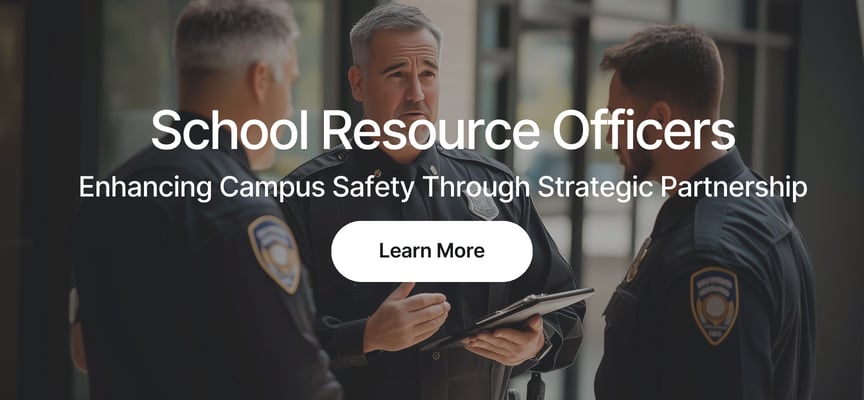As schools continue to prioritize campus safety, School Resource Officers (SROs) remain a cornerstone of comprehensive security strategies. Recent data shows that approximately 58% of public schools have at least one sworn law enforcement officer present weekly.
However, the role of SROs has evolved far beyond traditional security enforcement, creating opportunities for enhanced safety through strategic integration with modern security technologies.

1. Immediate Emergency Response Capability
In today's educational environment, the speed of emergency response can make a critical difference in incident outcomes. Having an SRO on campus provides schools with immediate response capabilities during critical situations, potentially saving precious minutes when every second counts.
School Resource Officers bring not only their physical presence but also their professional judgment and training to emergency situations, allowing for immediate assessment and appropriate response scaling.
Their ability to quickly evaluate threats and coordinate with local law enforcement proves invaluable during critical incidents. This rapid-response capability becomes even more powerful when enhanced with modern security technology, which can provide real-time situational awareness and automated alerts that help SROs respond even more quickly and effectively to emerging situations.
How SROs Provide Rapid Response:
- Physical presence enables immediate reaction to security threats
- Direct communication with local law enforcement expedites additional support
- Professional assessment of threat levels informs response protocols
- Coordination of emergency medical services when needed
- Implementation of immediate lockdown procedures if necessary
When combined with AI-powered security systems, SROs can respond even more quickly, receiving real-time alerts and accessing immediate video feeds of developing situations.
Everything you want to learn about School Resource Officers in one location.
2. Preventive Problem Solving
Prevention represents one of the most valuable yet often overlooked aspects of school safety programs. SROs serve as proactive problem solvers, identifying and addressing potential issues before they escalate into serious incidents.
Their daily presence and interaction with students creates opportunities for early intervention that simply wouldn't be possible with reactive security measures alone. Through their training in behavioral assessment and their understanding of adolescent development, SROs can recognize warning signs and intervene appropriately, often resolving situations before they develop into safety concerns.
This preventive approach not only enhances school safety but also helps maintain a positive learning environment by addressing issues at their earliest stages.
Preventive Measures Include:
- Regular security assessments of campus facilities
- Identification of at-risk students through daily observation
- Development of intervention strategies with school administration
- Implementation of security awareness programs
- Monitoring of social media and community concerns
Modern technology can enhance these preventive capabilities by providing behavioral analytics and pattern recognition that help SROs identify potential security concerns early.
3. Strong Community Relations
The relationship between schools and their surrounding communities plays a crucial role in maintaining comprehensive safety and security. SROs act as a vital bridge between the school, local law enforcement, and the broader community, fostering trust and cooperation that enhances overall safety.
By serving as visible, approachable representatives of law enforcement within the educational environment, SROs help break down barriers and build positive relationships that can last for generations. This community connection becomes particularly valuable during critical incidents or emergencies, when established trust and clear communication channels can make a significant difference in response effectiveness.
The presence of an SRO also helps create a sense of shared responsibility for school safety among students, parents, staff, and community members.
Community Building Activities:
- Regular interaction with students in positive settings
- Participation in school events and activities
- Communication with parents and community members
- Coordination with local law enforcement agencies
- Development of community-based safety programs
This human element of security remains irreplaceable, though it can be supported by technology that helps SROs maintain more consistent community engagement.
Read the Complete Guide: The Future of School Security in the Modern Era
Read the Complete Guide: The Future of School Security in the Modern Era4. Professional Security Expertise
The complexity of modern school security requires a level of expertise that goes far beyond basic safety measures. SROs bring law enforcement expertise directly into the educational environment, providing valuable insights and professional security knowledge that would be difficult and expensive to access otherwise.
Their background in law enforcement combined with specialized training in school-based policing enables them to understand both security best practices and the unique challenges of maintaining safety in an educational setting. This professional expertise becomes particularly valuable when schools need to develop or update their security protocols, investigate incidents, or ensure compliance with evolving safety regulations.
SROs can also provide crucial guidance on the implementation and use of modern security technology, helping schools create more effective, integrated security solutions.
Areas of Professional Contribution:
- Development of comprehensive security protocols
- Training staff in emergency response procedures
- Advice on security technology implementation
- Investigation of security incidents
- Compliance guidance for safety regulations
This expertise becomes even more valuable when SROs can leverage advanced security technology to enhance their professional capabilities.
5. Student Mentorship and Education
The impact of School Resource Officers extends far beyond their immediate security responsibilities into the realm of positive youth development and education. Beyond their security role, SROs serve as mentors and educators, helping create a positive school culture that naturally enhances safety.
Through daily interactions with students, they have unique opportunities to build relationships, provide guidance, and serve as positive role models. This mentorship aspect of their role is particularly valuable in helping students develop healthy attitudes toward law enforcement and authority figures.
Many SROs report that their most significant contributions to school safety come not from responding to incidents, but from preventing them through relationship-building and informal counseling with students who might otherwise make poor choices.
Educational Impact:
- Delivery of safety education programs
- One-on-one mentoring of at-risk students
- Teaching about law enforcement careers
- Guidance on personal safety practices
- Building positive perceptions of law enforcement
While technology can't replace this human connection, it can free up SROs to spend more time on these valuable mentorship activities by automating routine security monitoring.
Read the Case Study: How a Public High School Transformed School Security
6. Enhanced Emergency Management
Comprehensive emergency management requires more than just having response plans on paper – it demands expertise in preparation, practice, and real-world implementation. SROs play a crucial role in preparing for and managing emergency situations, ensuring schools are ready to handle various security scenarios.
Their experience in law enforcement gives them unique insights into potential threats and effective response strategies, while their daily presence in the school environment allows them to understand how these strategies need to be adapted for their specific campus. This combination of professional knowledge and local expertise proves invaluable in developing and implementing emergency response plans that are both thorough and practical.
SROs also bring vital connections to local emergency services, helping ensure coordinated responses during critical incidents.
Emergency Management Responsibilities:
- Development of emergency response plans
- Coordination of safety drills and training
- Assessment of security vulnerabilities
- Management of crisis situations
- Documentation of security incidents
Modern security technology can significantly enhance these capabilities by providing real-time situational awareness and automated emergency notifications.
Learn More: Complete Guide to School Resource Officers
7. Resource Optimization
In an era where schools must carefully balance security needs with budget constraints, the efficient use of safety resources becomes increasingly critical. When properly integrated with modern security technology, SROs help schools optimize their safety resources, creating more comprehensive security coverage while maximizing the return on security investments.
This optimization goes beyond simple cost savings – it's about creating synergies between human expertise and technological capabilities that enhance overall safety outcomes. By leveraging advanced security technology to handle routine monitoring and detection tasks, SROs can focus their time and expertise on activities that require human judgment, relationship building, and complex problem-solving.
This strategic approach helps schools create more effective security programs while making the most efficient use of both human and technological resources.
Optimization Benefits:
- More efficient security patrols guided by AI analytics
- Extended monitoring coverage through technology integration
- Better allocation of human resources based on data insights
- Reduced response times through automated alerts
- More effective incident documentation and reporting
This strategic combination of human expertise and technology creates a force multiplier effect that enhances overall school safety.
Maximizing SRO Effectiveness and Costs Through Technology Integration
To achieve the full benefits of an SRO program, schools should consider implementing a hybrid approach that combines officer expertise with modern security technology. This integration creates a comprehensive security solution that leverages both human insight and technological capabilities.
Key Integration Strategies:
- Implement AI-powered video surveillance to support SRO monitoring
- Provide mobile alert systems for immediate notification
- Use interactive campus mapping for improved response coordination
- Deploy behavioral analytics to identify potential security concerns
- Establish automated reporting systems for incident documentation
Final Thoughts
School Resource Officers provide invaluable benefits to educational communities, from immediate emergency response to long-term relationship building. By enhancing these benefits through strategic integration with modern security technology, schools can create safer, more secure environments that support both their security and educational missions.
This combination of human expertise and technological capability represents the future of school safety, offering comprehensive protection while maintaining the supportive atmosphere essential for learning.





